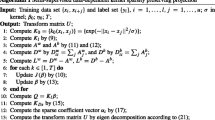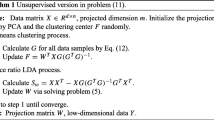Abstract
The dimensionality reduction of the unbalanced semi-supervised problem is difficult because there are too few labeled samples. In this paper, we propose a new dimensionality reduction method for the unbalanced semi-supervised problem, called sparse locality preserving projection (SLPP for short). In the past work of solving the semi-supervised dimensionality reduction problems, they either abandon some unlabeled samples or do not utilize the implicit discriminant information of unlabeled samples. While, SLPP learns the optimal projection matrix with the full use of the discriminant information and the geometric structure of the unlabeled samples. Here, we preserve the geometric structure of the rest unlabeled samples and their k-nearest neighbors after increasing the number of labeled samples by label propagation. The optimization problem of SLPP can be easily solved by a generalized eigenvalue problem. Results on various data sets from UCI machine learning repository and two hyperspectral data sets demonstrate that SLPP is superior to other conventional reduction methods.





Similar content being viewed by others
References
Jain AK, Duin RPW, Mao J (2002) Statistical pattern recognition: a review. IEEE Trans Pattern Anal Mach Intell 27(11):1502–1502
Jain A, Duin R, Mao J (2000) Statistical pattern recognition: a review. IEEE Trans Pattern Anal Mach Intell 22(1):4–37
Thomsen E (2010) Dimensionality reduction. US, US 7797320 B2
Hastie T, Buja A, Tibishirani R (1995) Penalized discriminant analysis. Ann Stat 23(1):73C102
Webb AR, and Copsey KD (1990) Introduction to Statistical Pattern Recognition. Academic Press
Yan S et al. (2007) Graph Embedding And Extension: A General Framework For Dimensionality Reduction. IEEE Transactions on Pattern Analysis & Machine Intelligence 29.1:40
Baudat G, Anouar F (2000) Generalized discriminant analysis using a kernel approach. Neural Comput 12(10):2385–2404
Li H, Jiang T, Zhang K (2006) Efficient and robust feature extraction by maximum margin criterion. IEEE Trans Neural Netw 17(1):157–165
Jolliffe I (2004) Principal Component Analysis, 2nd ed., Springer Series in Statistics
Bishop C (2006) Pattern Recognition and Machine Learning, Springer Series on Information Science and Statistics
Belkin M, Niyogi P (2001) Laplacian eigenmaps and spectral techniques for embedding and clustering. Adv Neural Inf Proces Syst 14(6):585–591
Borg I (2009) Modern Multidimensional Scaling: Theory and Applications
He X, Niyogi P (2004) Locality preserving projections. Proc Neural Inf Process Syst 16:153
Wang R, Nie F, Hong R, Chang X, Yang X, Yu W (2017) Fast and orthogonal locality preserving projections for dimensionality reduction. IEEE Trans Image Process 26(10):5019C5030
Qiao L, Chen S, Tan X (2010) Sparsity preserving projections with applications to face recognition, Pattern Recognit. 43 (January (1)) 331C341
Zhang, Daoqiang, Zhou, Zhi-Hua, Chen, Songcan. (2007). Semi-supervised dimensionality reduction. SIAM Data Mining https://doi.org/10.1137/1.9781611972771.73
Wei J, Peng H (2008) Neighborhood preserving based semi-supervised dimensionality reduction. Electron Lett 44(20):1190–1191
Baghshah MS, Shouraki SB (2009) Semi-supervised metric learning using pairwise constraints. International Joint Conference on Ijcai DBLP
Cai D, He X, Han J (2007) Semi-supervised Discriminant Analysis. IEEE, International Conference on Computer Vision IEEE, 1–7
Costa JA, Hero AO Classification constrained dimensionality reduction. IEEE International Conference on Acoustics, Speech, and Signal Processing, 2005. Proceedings IEEE, 2005: v/1077-v/1080 Vol.5
Wang S, Lu J, Sugiyama M, Ide T, Nakajima S, Sese J (2010) Semi-supervised local fisher discriminant analysis for dimensionality reduction. Mach Learn 78(1–2):35C61
Sugiyama M, Ide T, Nakajima S, Sese J (2010) Semi-supervised local fisher discriminant analysis for dimensionality reduction. Mach Learn 78(1–2):35C61
Lewis RJ et al (2014) Data clustering: 50 years beyond K-means. Pattern Recogn Lett 31(8):651–666
Antoniak CE (1974) Mixtures of Dirichlet processes with applications to Bayesian nonparametric problems. Ann Stat 2(6):1152–1174
Ferguson TS (1973) A Bayesian analysis of some nonparametric problems, Ann.Stat 209C230
Rasmussen CE (2000) The infinite Gaussian mixture model, Adv. Neural Inf. Process Syst. 12 554C560
Chen P et al (2017) Semi-supervised double sparse graphs based discriminant analysis for dimensionality reduction. Pattern Recogn 61:361–378
Wu H et al. (2017) Semi-Supervised Dimensionality Reduction of Hyperspectral Imagery using Pseudo-Labels. Pattern Recognition 74
Tibshirani R (1996) Regression shrinkage and selection via the lasso. J Royal Stat Soc Ser B 58(1):267C288
Chen SS, Donoho DL, Saunders MA (1998) Atomic decomposition by basis pursuit. SIAM J Sci Comput 20(1):33C61
Xu ZB, Zhang H, Wang Y, Chang XY (2010) L 1/2 regularization. Sci. China 53(6):1159C1169
Chartrand R, Staneva V (2008) Restricted isometry properties and non-convex compressive sensing. Inverse Problems 24(3):20C35
Chartrand R (2009) Fast algorithms for nonconvex compressive sensing: MRI reconstruction from very few data. IEEE International Conference on Symposium on Biomedical Imaging, Boston, Usa 262–265
Chartrand, Rick, and W. Yin. Iteratively reweighted algorithms for compressive sensing. IEEE International Conference on Acoustics, Speech and Signal Processing IEEE, 2008:38693872
Chartrand R (2007) Exact reconstruction of sparse signals via nonconvex minimization. IEEE Signal Process Lett 14(10):707–710
Foucart S, Lai MJ (2009) Sparsest solutions of underdetermined linear systems via [formula omitted]-minimization for [formula omitted][J]. Appl Comput Harmon Anal 26(3):395–407
Zou H (2006) The adaptive lasso and its Oracle properties[J]. J Ind Manag Optim 101(476):1418–1429
Chartrand R (2007) Exact reconstruction of sparse signals via nonconvex minimization[J]. IEEE Signal Process Lett 14(10):707–710
Acknowledgements
This paper is supported by National Natural Science Foundation of China (No. 11301535, No.11371365).
Author information
Authors and Affiliations
Corresponding author
Additional information
Publisher’s note
Springer Nature remains neutral with regard to jurisdictional claims in published maps and institutional affiliations.
Rights and permissions
About this article
Cite this article
Guo, H., Zou, H. & Tan, J. Semi-supervised dimensionality reduction via sparse locality preserving projection. Appl Intell 50, 1222–1232 (2020). https://doi.org/10.1007/s10489-019-01574-6
Published:
Issue Date:
DOI: https://doi.org/10.1007/s10489-019-01574-6




